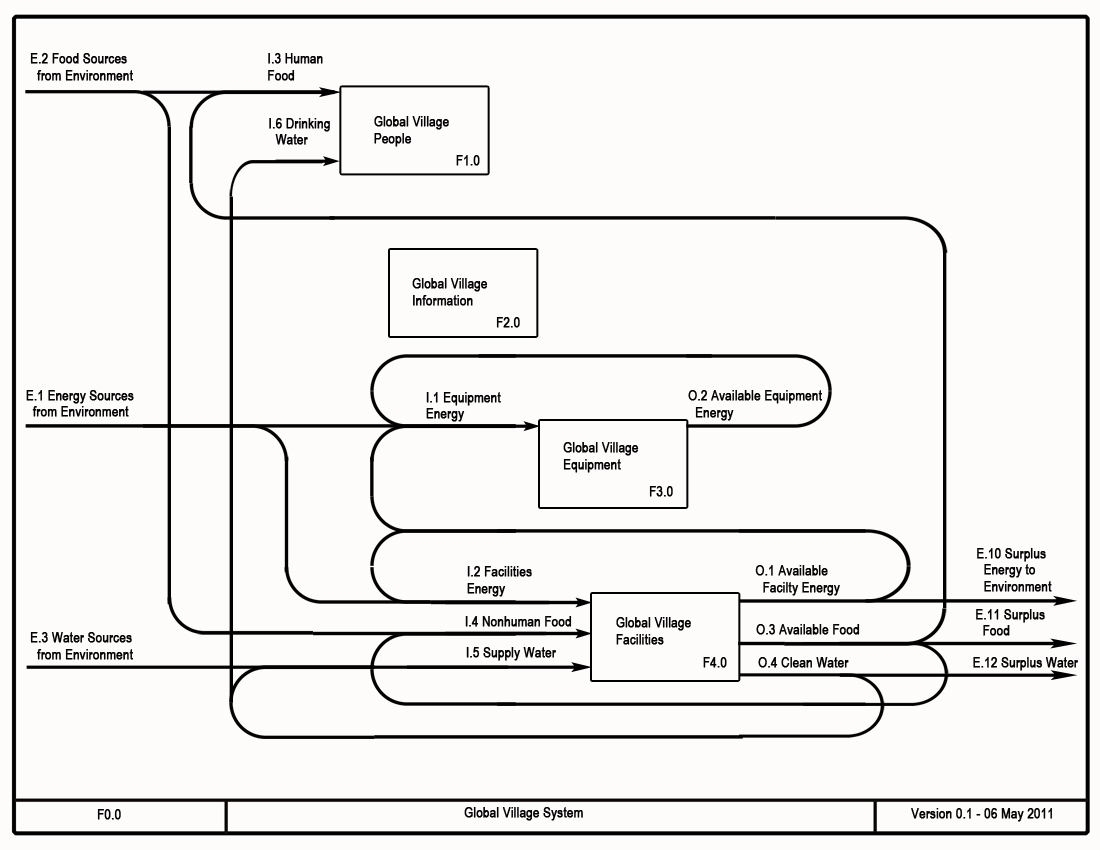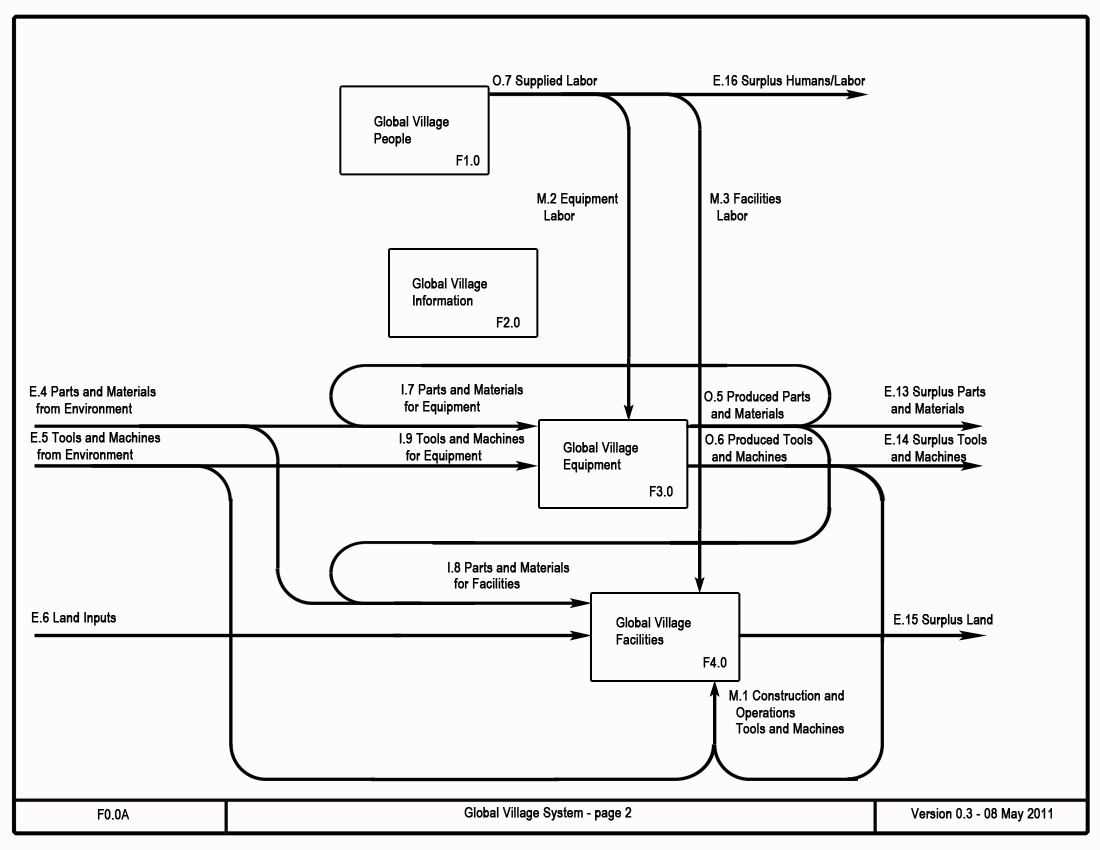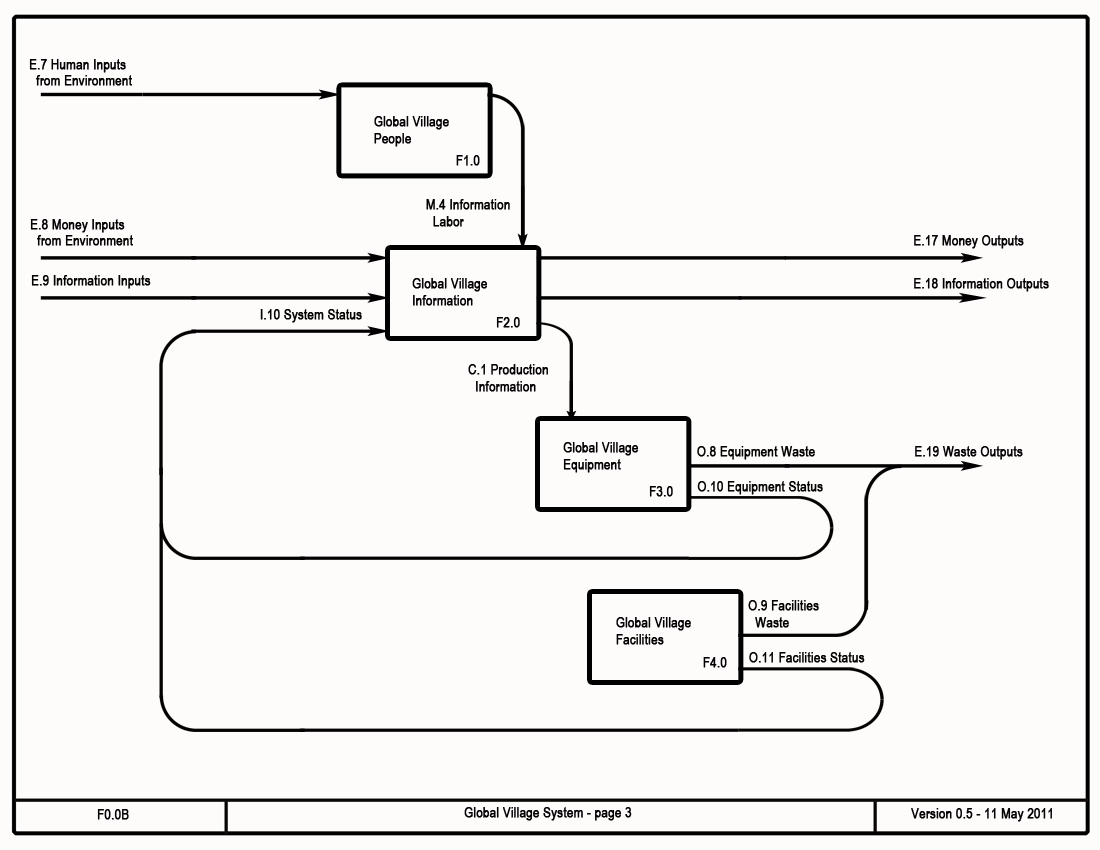Functional Block Diagram F.0 Global Village System
Diagrams
Notes
(1) When too many flows exist to show on a single page, they are displayed as multiple pages. It is still a single diagram, merely split for readability.
(2) Some flows may be zero amount depending on design.
(3) Diagram is an early draft as of version 0.5 11 May 2011.
Description
The Global Village System as a whole includes several top level functions. A function converts its inputs to its outputs using mechanisms and according to controls. For a function such as "cut metal parts", a control is a cutting diagram for a metal sheet. The inputs would be an uncut sheet plus electric power, and the outputs would be cut parts plus cutting scraps. The mechanisms would a plasma cutter machine plus human labor to operate the machine. Functions are represented as boxes on these diagrams. Each box then gets broken down to more detailed functions on its own diagram. At the lowest level a single function box is simple enough to design for.
Numerical values should generally not be included in the diagrams themselves. They are subject to change as the design progresses or become a variable when you do an analysis. Instead note them in the description, or enter them into a system model, such as an Input/Output spreadsheet.
F1.0 Global Village People - This includes all the people connected to a village, both working and non-working. The latter are included because they use flows generated by other functions, such as food. Working people includes owners, paid staff, hired contractors, bartered labor, and volunteers. It can be full or part time. Non-working people includes guests.
F2.0 Global Village Information - This includes all information needed to construct, operate, and maintain the system. Types of information include drawings, manuals, procedures, and training. Tasks within this function include planning, scheduling, accounting, purchasing items, and taking orders for production.
F3.0 Global Village Equipment - This includes machines such as the Global Village Construction Set, other tools, parts, and materials. A given machine may have hardware, software, and supplies needed to operate it.
F4.0 Global Village Facilities - This includes land, buildings, and outdoor modifications/additions. Generally items permanently attached to the ground are included as facilities. A device such as a wind turbine could also be counted as equipment, so the distinction is somewhat arbitrary. The important thing is to only list a given item in one place, and track the flows going in and out of it.
Flow is the general term for anything that goes from one place to another in the system. They are represented as arrows on these diagrams. As you develop more detail in the functions to be performed, it exposes more details of the flows at the same time. Every flow needs both ends accounted for. They do not appear or vanish from or to nothing. The "no loose ends" rule ensures all parts of the system are accounted for. Internal flows are categorized as controls, inputs, mechanisms, and outputs. They can merge and split as needed when they connect different functions, and change types at the ends. For example the output of a biofuel extractor can become the input of fuel for machines. That flow can then divide into the fuel input for each machine. A merged flow simply represents the total of its lower level component flows.
External flows to this diagram cross the system boundary, since this is the top level diagram. The flows entering and leaving the external environment are shown on diagram E.0 Environment. Internal flows connect functions to each other or represent part of an external flow. Internal flows are categorized as controls, inputs, mechanisms, and outputs. Functions and flows are numbered for reference and make it easier to track across diagrams. The numbers start with F, E, C, I, M, and O for the different kinds, and then a unique number.
C.1 Production Information - This includes a schedule of tasks and products for the F3.0 Equipment. It also includes instructions for operating the equipment, assembling the products, and drawings or computer aided manufacturing files for the products.
I.1 Equipment Energy - This is the sum of energy inputs to all the equipment. This includes energy supplied from one machine to another, from available facility energy, and solar, and electric energy supplied from outside the system.
I.2 Facilities Energy - This is the sum of energy inputs to all the facilities. This includes energy supplied from one facility to another, and energy supplied from outside the system (solar, electric, moving water, etc).
I.3 Human Food - This includes the human portion of available food produced by F4.0 Facilities plus part of E.2 Food from outside
I.4 Nonhuman Food - This includes food for pets, livestock, and plants. Sources are part of available food produced by F4.0 Facilities plus part of E.2 Food from outside.
I.5 Supply Water - This is water entering F4.0 Facilities. Water distribution to point of use is part of the Facilities function, including clean water for drinking. It does not include well water since that is internal to the land component. It does include rain, streams, and public water supply as those enter from outside the system via E.3 Water Sources from Environment.
I.6 Drinking Water - This is the portion of clean water used by humans for drinking. Additional clean water stays within F.0 Facilities for household use (cooking, cleaning, showers), pets, and livestock. Other water, such as for sanitation and irrigation, does not necessarily have to be clean to drinking standards. Meeting local requirements for water purification and testing may be required.
I.7 Parts and Materials for Equipment - Parts are objects which do not perform a complete function by themselves, and need to be assembled with other parts. Materials include fuels, lubricants, and stock to be converted into parts. Sources include the land part of facilities, produced parts and materials from the F3.0 Equipment function, and from outside the system via E.4 Parts and Materials from Environment.
I.8 Parts and Materials for Facilities - This is similar to I.7 except sources from land is internal to F4.0 and so not an input. Sources for this flow are produced parts and materials from F3.0 Equipment and from outside the system via E.4 Parts and Materials from Environment.
I.9 Tools and Machines for Equipment - These are items which perform a complete function by themselves and are obtained from outside the system. An example is a two-cycle engine for the power cube. Tools are unpowered, for example a metal forming die. Machines are powered, for example a hydraulic press. In detail they are listed by function, such as transport, parts making, or assembly.
I.10 System Status - This is information fed back from F3.0 Equipment and F4.0 Facilities. Examples are wind turbine electric output or soil moisture sensor reading. The information would get used for planning and scheduling other tasks, such as when to irrigate a field. Usually this would require combining several pieces of information, in this case weather forecast in addition to soil readings.
Mechanisms are the category of flows that do not get converted when performing a function. For example a tractor converts an unplowed field into a plowed field, but the tractor itself is unchanged.
M.1 Construction and Operations Tools and Machines - This is the total flow of mechanisms to build and operate the F4.0 Facilities. It is the sum of produced tools and machines plus those supplied from outside the system (purchased, donated, leased, traded, or borrowed). Parts and materials that get used up are treated as inputs.
M.2 Equipment Labor - This is the total human labor required to build and operate the F3.0 Equipment. It is found by summing the individual labor needed for each equipment item. In turn it is part of the total O.7 Supplied Labor. When broken down into more detail it is represented by different skills such as tractor operator or welder.
M.3 Facilities Labor - This is similar to M.2, except for being labor required for F4.0 Facilities.
M.4 Information Labor - This is similar to M.2, except for being labor required for F2.0 Information. Information tasks in
O.1 Available Facility Energy - This is the total energy output of the F4.0 Facilities. Energy generated and used by one facility internally is not counted as part of this output. Energy transferred from one facility to another is counted. It also includes energy to run F3.0 Equipment and any surplus that leaves the system. Examples of surplus are biofuel or extra electric power delivered outside the village system. It can be in the form of mechanical, electrical, fuel, charged batteries, or other forms.
O.2 Available Equipment Energy - This is similar to O.1 except for equipment. Energy transferred from one equipment item to another is included here. If any is supplied to facilities or outside the village system, it would also be included.
O.3 Available Food - This is the total food food produced by facilities such as fields, orchards, and greenhouses. It includes food used by livestock, for humans, and surplus food delivered outside the system.
O.4 Clean Water - This is purified water suitable for drinking supplied to humans and livestock, and as needed for agriculture, equipment, and facilities. Other types of water will likely be used elsewhere in the system, such as grey water from living space, fish pond water with nutrients for plant watering, etc.
O.5 Produced Parts and Materials - This is the output of the F3.0 Equipment, some of which feeds back for internal use. For example lumber output from the sawmill to be used in constructing buildings, or fabricated metal parts to build more machines.
O.6 Produced Toola and Machines - This is the output of the F3.0 Equipment which are complete tools and machines. They are used within a facility or sent out of the system as surplus.
O.7 Supplied Labor - This is the total human labor of all kinds, found by summing component labor flows M.2 + M.3 + M.4 + E.16.
O.8 Equipment Waste - This is any items from equipment which cannot be recycled or processed internally and must be sent out of the system. Ideally this would be zero, but likely it will not be. As a goal the Village system should consume more waste, such as scrap metal from outside, than it produces.
O.9 Facilities Waste - This is any items from facilities which cannot be recycled or processed internally or emitted to the environment. Ideally this would be zero or negative. Negative waste is possible, for example, if more carbon is added to fields and trees than emitted elsewhere in the system. As a goal the system should be waste negative, and what wastes are sent out should be more benign than incoming items.
O.10 Equipment Status - This is any kind of data fed back from the Equipment function to the Information function. An example would be a daily production report, so that the future production schedule can be updated.
O.11 Facilities Status - This is any kind of data fed back from the Facilities function to the Information function. An example would be net power meter readings, so that future power costs can be updated. Net metering is when the electric utility buys surplus power from the system when it produces a surplus, and the Village buys needed power at other times, and the final bill is based on the net difference.
Links to Related Diagrams
Higher Level: E.0 Environment
Controls: (To be done)
Functions: F.1 Global Village People, F.4 Global Village Facilities
Inputs: (To be done)
Mechanisms: (To be done)
Outputs: (To be done)
Mechanisms: (To be done)


